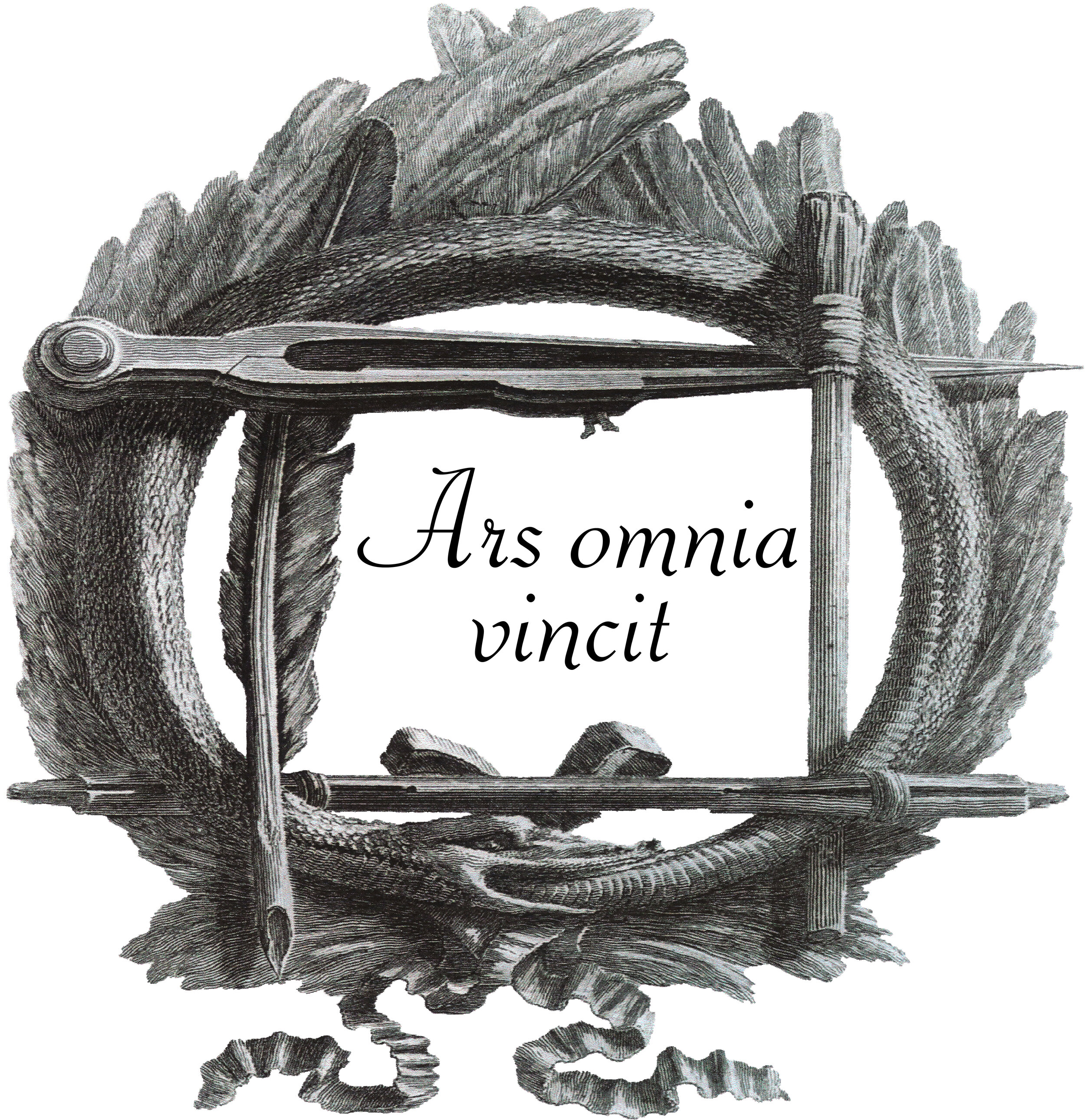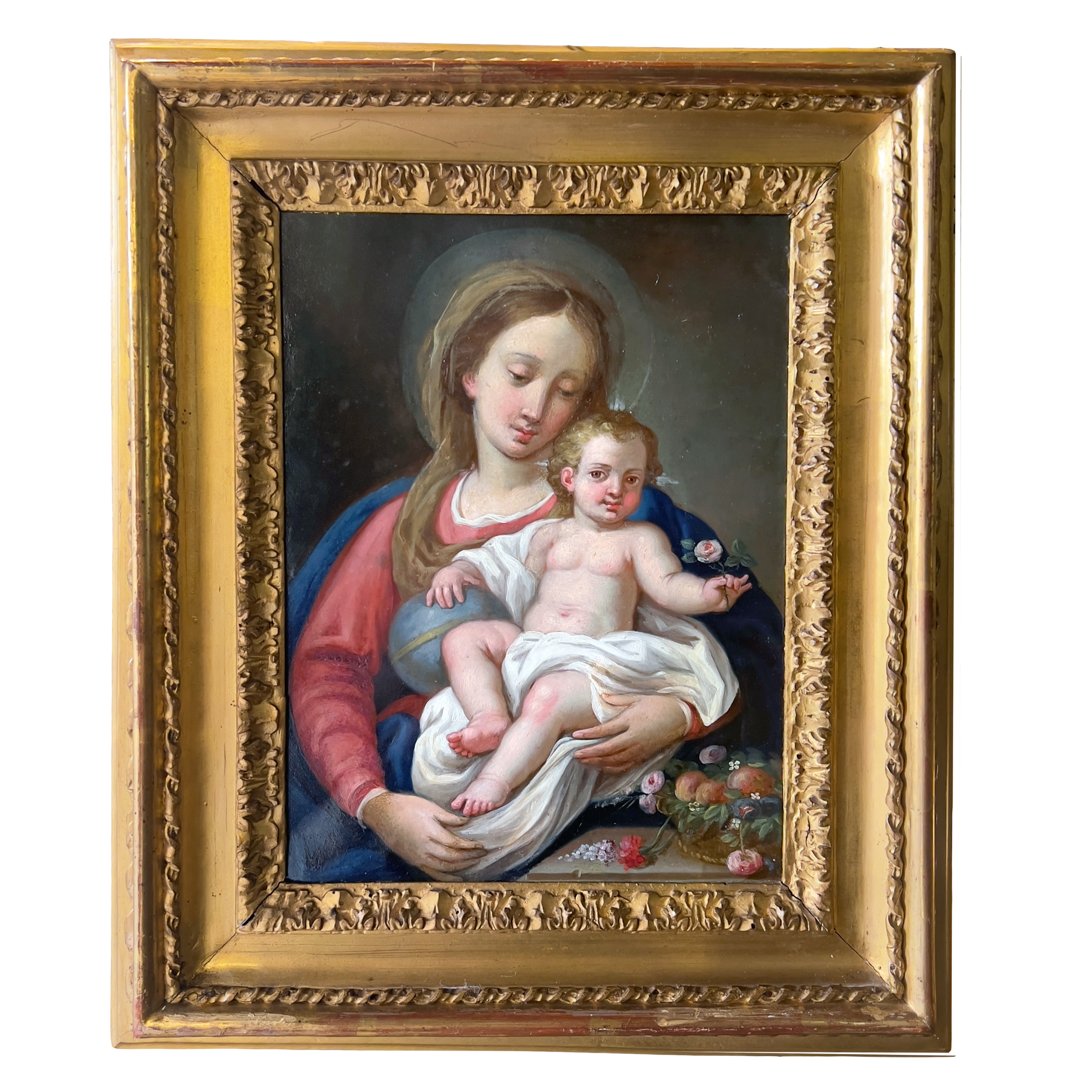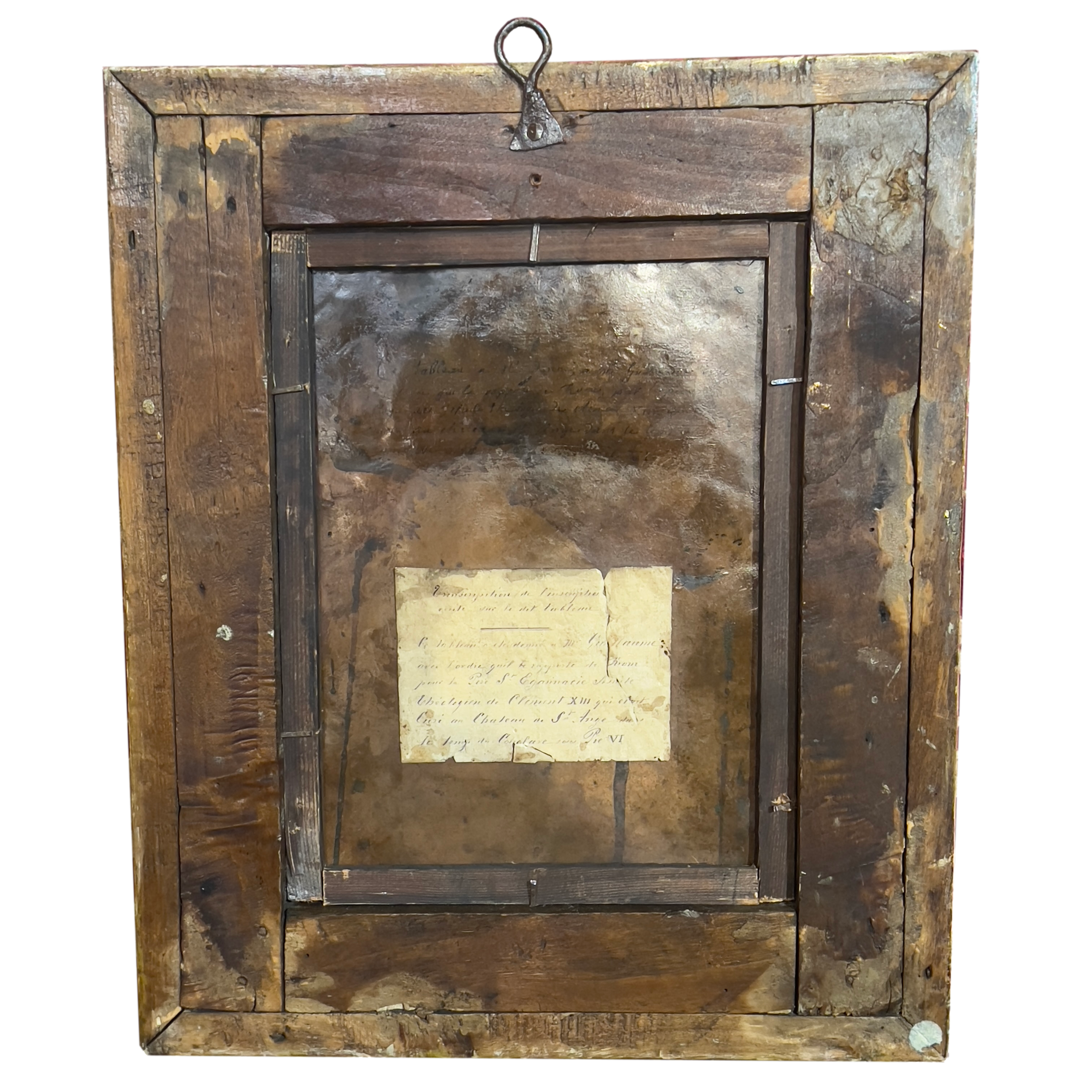The Holy Family Rome 18th cent.


The Holy Family Rome 18th cent.
Extremely fine oil painting on copper depicting the Holy Family within a beautiful contemporary three-orders carved and gilded wood frame.
Roman school of the first half of the 18th century, around 1720/30.
Attributable to the circle of Girolamo Pesci (Rome 1679-1759).
Dimensions 20 x 15.5 cm the painting - 37 x 31 cm with frame.
Excellent conditions commensurate with age. Restorations.
Pesci, Girolamo Maria was born in Rome in 1679. The names of the parents are not known; a Pesci family, originally from Città della Pieve, had settled in Filettino, near Frosinone, where Pesci made some altarpieces for two places of worship (Paonessa, I, 2014, p. 26) He studied for eight years with Carlo Maratta, from whom he learned the correct drawing and balanced composition, then moved on to the school of Francesco Trevisani, from which he learned an unusual color scheme, with unexpected combinations that were the hallmark of his pictorial production. The first document that recalls Pesci as an independent artist is dated 10 October 1699, when he collected thirty shields for having painted a new processional banner, lost, for the Archconfraternity of the Gonfalone, in anticipation of the jubilee year 1700, during which he also accommodated the old processional banner (Randolfi, 2014, pp. 416-419). Probably thanks to Maratta, in 1704, Pesci executed the fresco for the ceiling of the sacristy of S. Onofrio, quoted by Nicola Pio and dated erroneously by him in 1724, with S. Onofrio the Faith, Hope and Charity where it is noted a dynamic layout, played on the diagonals, enlivened by a pleasant color (Mandolesi, 1999, p. 205). Perhaps of that period is the Self-portrait, now in the Stockholm National Museum, painted for Nicola Pio, his most important biographer. Still substantially marattesca reveals the Madonna and Child appearing to the SS. Fabiano and Sebastiano, executed in 1713 for the church of the Confraternita dello Santo Spirito in Carignano. In the same year Cardinal Pietro Ottoboni, known by means of Trevisani, exhibited the series with the Savior, the Virgin and the Apostles at the annual exhibition in the cloister of S. Salvatore in Lauro, including S. Barnaba di Pesci ( beaten at a Christie's auction on 22 January 2006, lot 31). Between 1714 and 1724 Pesci fired the altarpiece with S. Teresa d'Avila, S. Francesco Saverio, S. Carlo Borromeo for the church of the Fathers of S. Bernardo in Turin, dispersed, but mentioned by Nicola Pio, and sent to England a Madonna, now in Oxford, and Il Bagno di Callisto, to Wilton. In 1716 he was welcomed among the members of the Virtuosi al Pantheon. The dating of the two altarpieces for S. Maria delle Grazie in Zagarolo (Rome), with the Immaculate Conception with S. Agostino and S. Giovanni Evangelista and Santi Giuseppe, Anna, is uncertain, but can be limited in the early 1920s. and Domenico and the Marian monogram. The loss of the documents of the conventual fathers, in fact, does not allow to understand if the works, which are cut on the margins, were made specifically for this church or if they come from the destroyed temple of the conventuals of Gallicano, the to which the furniture was entirely transferred, in accordance with the brief of Benedict XIV of 17 February 1748, in the new church of the fief acquired in 1670 by Rospigliosi, great admirers of Maratta, who promoted a campaign of renewal from an architectural and decorative point of view in early decades of the 18th century. The portraits of Maria Clementina Sobiescki (Madrid, Prado) and the one with Maria Clementina Sobiescki with Prince Charles (Lutterworth, Stanford Hall) can be dated back to 1721. These effigies had already been remembered by Pius. The link between the Stuarts and Pisces could be found in Cardinal Filippo Antonio Gualtieri, a friend of his and of his teacher Trevisani, commissioned by the pope to deal with the story of the Catholic king James II Stuart driven from England and welcomed by the court of France, where the prelate had served as papal nuncio from 1700 to 1706. In the inventory of the silversmith's property Giardini, from 1722, two half-heads of Pisces satyrs were mentioned. Between 1722 and 1726 Cardinal Ottoboni promoted restorations in the church of S. Francesco di Bolsena, entrusting the direction to Andrea Adami, master dean of the chaplains, singers of the pontifical chapel, in contact with Trevisani and with Pesci, who painted the ceiling with S. Francesco he receives the stigmata and the Assumption of the Virgin and another canvas with S. Francesco in ecstasy. In 1724 the same prelate paid Pisces for a head of Moretta. Still in these years the Madonna in glory with S. Giovanni Battista and S. Giovanni Evangelista referable to St. Francis on the vault of the sacristy of the church of the Stigmata in Rome, commission perhaps obtained once again by means of Trevisani, author for the same place, two altarpieces. By 1723 Pesci painted, in the parish church of Maria SS. Taken into the sky by Filettino, two paintings: one with the Assumption of the Virgin for the main altar, the other of an unspecified and lost subject, but remembered by the local poet Eleuterio Arquati on the altar to the right of the main one, dedicated to the Name of Jesus, mentioned in the pastoral visit of that year conducted by the bishop of Anagni Giovanni Battista Bassi (Paonessa, 2014, I, p. 26). Perhaps from the same period there is also a Holy Trinity with S. Francesco and S. Nicola di Bari in the oratory of the SS. Trinity of the same Ciociara town. Even the angels on a yellow background frescoed on the dome of the same place seem to belong to the same hand (Paonessa, 2014, I, p. 27). Nicola Pio, who had held the role of adviser for the erection of the Rospigliosi picture gallery and therefore knew Pesci and the other minor artists, all pupils of Maratta and to whom he dedicated a monograph, attributed to Pesci a S. Antonio Abate, surely finished within 1724, the year of the publication of his work, in the church of Gesù and Maria in via del Corso in Rome, lost and replaced in 1765 by another canvas dedicated to the new patron saint of the chapel, S. Anna, painted by Ermenegildo Costantini. meanwhile Pesci had gone to live in Piazza di Spagna, on the left side towards the Paolina road, as shown by the States of Souls of 1725 in the parish of S. Andrea delle Fratte, which shows that he was forty-five years old and lived with his wife Francesca Torregiani, forty years old, and the children Caterina of nineteen, Virginia of seventeen, Giuseppe of fifteen, future painter, and five-year-old Eustachio. It is mentioned in the lists of the same parish again for 1731 and 1732. Through the Arcadia Academy, the two Hungarian brothers Michele Federico and Michele Carlo Althann came into contact with Pietro Metastasio and the circle of Cardinal Ottoboni. Michele Federico commissioned six canvases from Pesci, five of which were destined for the diocese of Vàc. Among them the Martyrdom of S. Gennaro (once in the sacristy of the Gothic church of S. Michele) and San Bernardo presenting his De consideration Libri V to Pope Eugene III, San Bernardo scolding his sister and La Vergine Maria e S Bernardo di Chiaravalle among the divine gifts of the Madonna, signed, dated 1727 and preserved in the sacristy and chapel of the Virgin of the Cathedral, a Virgin and Child, in Vácrátot, another canvas in Arayosmarót, both from 1727, and a Crucifixion (1729) at the Budapest Museum of Fine Arts. Pesci painted and signed reporting the date, 1728, the canvas with Saints Domenico, Francesco di Paola and Leonardo in adoration of the Trinity for the church of S. Pietro di Zagarolo. In 1732 he signed and dated a Bathsheba to the bathroom, (Brno, Moravske Museo). In 1733 also the Pallavicini, relatives of the Rospigliosi, contacted Pesci, perhaps through the architect Ludovico Rusconi Sassi, for the realization of the three ovals with the Wedding of the Virgin, the Nativity and S. Vincenzo Ferrer (attr. Paonessa, 2014, p. 93) for the church of S. Andrea in Gallicano. The canvases, welded in 1734, now blackened and in a poor state of conservation, testify to an involution in the style of Pesci, which proves to be more conventional, as highlighted by R. Engass (1975-76, p. 49; 1991, p. 191), also with regard to private commissions such as the Sacrifice of Noah in the gallery of Palazzo Chigi in Ariccia, once in the Lemme collection, dated 1735. In March of 1734 Pisces delivered the altarpiece with the Virgin, St. Joachim and St. Anna for St. Joseph alla Lungara, where his friend Rusconi Sassi was also active, whose model is kept in Calvi (Benevento) in the Ursuline monastery , commissioned by the pious workers' fathers for whom Pesc the later he painted the walls of the staircase that connected the church of S. Balbina to the house of the same fathers, restored in 1813, 1825 and 1931. Signed and dated 1738 is a painting with Diana and Actaeon (beaten at a Christie's auction on October 26, 1973, lot 129). For the choir of the Roman church of S. Maria Maddalena Pesci he painted some pictures concerning episodes from the life of S. Camillo de 'Lellis, no longer on site, while the altarpiece with the Assumption of the Virgin and the fresco, retouched at tempera and surrounded by angels and flowers where it reveals all its technical mastery, the ceiling of the sacristy with the Glory of St. Camillus de 'Lellis and Filippo Neri welcomed into the sky by the Immaculate Conception of 1739. The model for the decoration of the sacristy is preserved in the Marini collection of Rome, close to these works there is the S. Carlo Borromeo panel made for the Giustiniani palace in Bassano, donated by Prince Vincenzo to the local church of S. Maria Assunta. Moreover, Pesci had also drawn up the inventory of Caterina Giustiniani Savelli's assets. Still by 1739 he painted the Ecstasy of St. Francis and St. Mary Magdalene for the Sacchetti Sassetti of Rieti (donated by Angelo Sacchetti Sassetti, in 1958, to the local Civic Museum). In the church of Santa Scolastica in Rieti, now deconsecrated and used as an auditorium, Pesci left an Assumption with San Benedetto, Santa Scolastica, Santa Margherita and San Silvestro Pope a few years later. The circle of admirers of Pesci had definitely widened: in the inventory of the assets of Pier Francesco Albiccini of 1739 there is an allegory of the sculpture, signed, executed as a pendant to an Allegory of the Painting of Trevisani, which in 1770 was found in the same collection in Forlì. In 1744 for Michele Carlo Althann, Pesci painted a Susanna in the bathroom (Vizovice castle, near Brno). In the same year he completed an Assumption of the Virgin and the Wedding at Cana (private collections). Dating between 1744 and 1745 is also a painting with the Israelites who collect manna, in a private Roman collection. The name of Pisces can be found, between 1749 and 1750, in the minutes of the Congregation for the Virtuous. In 1750 Pesci resided in the Vicolo del Merangolo, in the district of S. Lorenzo in Lucina, with a second wife, Angela Biondi, and other tenants. On December 18, 1752, the Chracas reported the news of Pesci's sending to Hungary paintings, one representing the Virgin seated with the Child in her arms, and the other S. Paul the first hermit, of which there is no more news. Pesci died in Rome in 1759, as reported by Nicola Pio. In 1814 Mariano Vasi remembered a Baptism of Christ in the Gallery of paintings of the Vatican Museums. On the basis of what Pius said, Pesci sent many paintings to England. Among these, perhaps the model for a ceiling with the Glorification of a saint bishop (appeared at a Christie's auction in London on 12 December 1987, lot 143) and a Rebecca at the well (beaten at an auction Christie's in London on 29 October 2003, lot 70), signed. Sestieri attributed to Pesci a Addolorata, a Preaching of himself. Giovanni Battista and a Nativity of Mary, in the Doria Pamphili gallery in Rome, and a s. Bernard in adoration of the Virgin in the sacristy of Var Cathedral in France. Paonessa refers to Pesci a small painting with Crucifix in the Doria Pamphili gallery in Rome. The following paintings have also recently appeared as attributed to Pesci: S. Paolo, Asta Roma Babuino, lot 50, June 8, 2010; The Virgin appears to St. Francis, Dorotheum auction, Vienna, April 18, 2012, lot 596; St. Anthony of Padua with the Child, Roma Babuino auction, 29 January 2013, lot 123.









